
Reagan saved us from the brink of disaster.
Chapter 7
|
TABLE
OF CONTENTS
|
114
By the fall of 1982, Reaganomics had completed its task of undoing the economic advances of recent years. Following the advice of the Chairman of the President's Council for Economic Advisers-"Don't stand there, undo something"- the dismantling of our Carter era prosperity had been fully accomplished and the sacrifice of the 150,000 victims of the recession was proceeding on schedule.(1)
Our ability to slow down the economy so thoroughly in less than two years was astonishing. One-third of America's productive capacity lay idle; over 12 million people (10.8 percent) were out of work, most with no unemployment benefits; real Gross National Product was dropping at a rate of 2 percent a year; over 2 million were homeless, many living in cars and tents along the road; over 40 million workers had lost their medical benefits; spending for child nutrition was cut by over $5 billion, pushing more than one in five children into poverty and raising infant death rates in areas worst affected by unemployment and federal cut-backs; government borrowing soared to $200 billion a year, a rate which would triple the national debt by the end of the decade; personal savings had dropped rather than increased as promised; businesses were failing at a far higher rate than in the 1930s; the foreign trade deficit was running over $4 billion a month; bank failures were triggering fears of a global collapse.(2) Reagan had done the job we had hired him to do. "What has been done so far, has been working very successfully," he told the country.(3) "The President seems . . . to be enjoying the job," said Time. " 'He is at peace with himself,' says White House Chief of Staff James Baker."(4)
| A CLEANSING THING | 115 |
The American people felt that their leader had done his job well. The majority of voters polled before the 1982 elections rated Reagan as good" or "excellent" on the economy. Another poll found that he was "the favorite American of all time," just ahead of Abraham Lincoln. One reporter, interviewing unemployed workers as they went into the voting booths, was told: "Well, Reagan said it was going to be painful. It is painful, but the pain will do some good." Another put it even more positively. "This recession has been a cleansing thing," he said, with relief.(5) On "Nightline," reporter Ted Koppel, interviewing a clergyman on Christmas eve whose church had fed thousands of hungry families out of work, asked him whether the recession might not be "a good thing," since it had helped the faithful "rediscover their Christian goals."(6)
Johnny Carson captured the public's approval for Reaganomics best in his opening monologue:
Carson: The Senate cut one million people off the food stamp rolls yesterday.
Audience: (Wild cheering, applause and laughter.)
Carson: Let's hear it from the truly mean
The response of professional economists to the total failure of Reagan's economic program to revitalize the country was two-fold. Most economists simply denied the reality and pronounced Reaganomics a success. As one put it: "After two years in power, President Reagan's Administration has made a miraculous improvement in the financial stability of the United States."(7) Those who could allow themselves to face the totality of the failure of Reagan's promise to produce "robust growth and a balanced budget" concluded that only Reagan had wanted Reaganomics. It was solely his fault, they said, because the entire country and all of Congress had been charmed by him against their will into approving the program. As the lead article on October 24, 1982 in The New York Times Magazine put it:
Mr. Reagan's painless means to economic recovery has failed to deliver on its promise of simultaneous low inflation, robust growth and a balanced budget.
Row could the nation have gone from hope to gloom in less than two years? . . . How could Mr. Reagan's economic plan have been enacted in the first place? . . . Mr. Reagan's closest friend on Capitol Hill, [Senator] Laxalt, [said], "If there had been a secret ballot in the Senate last year, there wouldn't have been more than 12 votes for the tax cut."
116
The Senator's astonishing statement passed without comment at the Cabinet Room, [yet] his words are worth pondering. Given all the misgivings about the program, how could it have happened?
Recently, in dozens of interviews with The New York Times, central figures in the Administration and Congress have explored that question . . . running-through all the comments of those interviewed was the image of a charming, insistent President-politically skilled, ideologically stubborn, a man who defied the odds and bent the public and the Government to his will.(8)
This, too, was why we had hired Ronald Reagan-to take all the guilt upon himself for the blood of the sacrificial victims. "He alone had "bent us to his will.''
Reagan played his part well. Having alone caused the economic disaster, he alone could now save us from it. Since the tax cuts and the strangulation of the money supply had created the recession, a tax in-crease and a sudden expansion of the money supply could save us at the brink of total collapse. Both of these miracles were easily accomplished. "The truth is," Reagan said, "we've . . . accomplished a minor miracle. We've pulled America back from the brink of disaster."

Reagan saved us from the brink of disaster.
Reagan was hailed as our savior, and within a few months the economy began to respond, as it had done so many times before, with signs of recovery. The Federal Reserve Bank, which until that time had been pulling money out of circulation, now let the money supply grow at an annual rate of 15 percent, allowing its discount rate for bank borrowing to drop to 8.5 percent by year's end, the lowest rate since 1978. We had decided America was not to have a Great Depression after all.
| GIVEN A NEW HEART | 117 |
| Reagan's decision to end the recession had an immediate effect on the stock market and on the mood of the nation. Cartoons in the fall of 1982 showed people floating in the air, as joyous as were the Aztecs who saw the new bonfires, indicating that the old polluted heart had been ripped out of the sacrificial victim and a new had been put in its place. In fact, the strong that group-fantasy that we had been given a new heart was so strong, that | 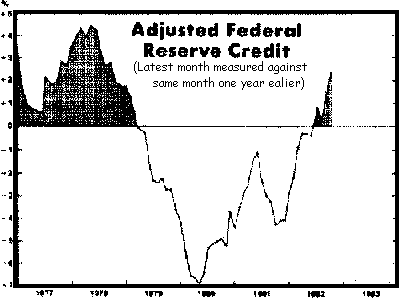 The economic sun rose above the horizon. |
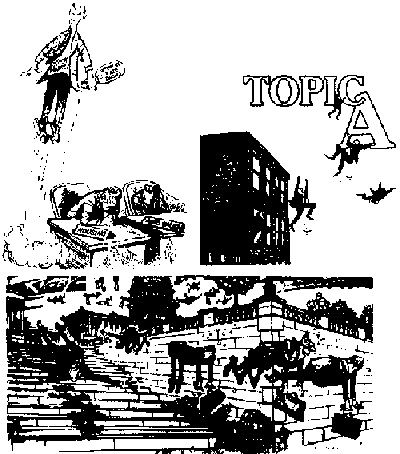
People floated in the air on hearing of the end of the
internal sacrifice.
118
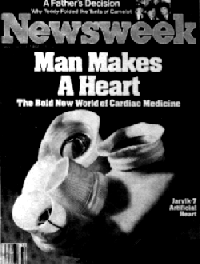 Like the Aztecs, we made a new heart |
when surgeons put an artificial heart into Barney Clark, we followed his "recovery" in front-page headlines and special TV programs - imagining, like the Aztecs, that every beat of his artificial heart would pump new, unpolluted blood into our body politic.(9) It did not matter that economic reality lagged far behind our fantasy of instant recovery. The media soon stopped reporting stories on the hungry and homeless-one reporter wondered why "the 'new poor' and homeless discovered by the press a few months ago seem to have vanished" (10) - and concentrated instead on Barney Clark's miraculous new heart. Perhaps the world could be renewed, perhaps. our polluted national bloodstream could be cleansed through the internal sacriflce alone. Perhaps we would not need a war to feel reborn. |
We soon realized it was not to be so simple. Even the Great Depression of the Thirties couldn't drain off all our poisonous feelings and required the blood sacrifice of the Second World War to really cleanse us.(11) Like Frosch's paranoid patient, once we began to slide into the psychotic pro-cess, our punitive superego more and more took control of our fantasy life, and every pleasure in life began to be seen as "poisonous."(10) Our na-tional superego-which a year earlier we had pictured as a disapproving "laser eye" Supreme Judge watching us-now declared that our newly reviving economic life was "poisonous" to our body politic. Poison group-fantasies proliferated in the media.
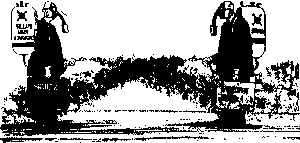 We imagined poison "yellow rain" in the air around us. |
The New York Times reported that "many Americans
keep saying, it's a poison in the body politic,"(12
)The New York Post imagined there was "poison oozing
from the White House,"(13) and Reagan announced that
"This Administration hereby declares an all-out war
on [those] who are poisoning our young people."(14) The poisoning group-fantasy was often projected into the Soviets, as when they were accused of poisoning Asians with "yellow rain chemical toxins, which scientists had |
| A VIRUS IN OUR BLOODSTREAM | 119 |
long ago shown to have been only bee excrement.(15) More often, however, it was our own economy which was used to convey our poisoning fantasies, either directly - as when Reagan likened the economy to "a poisonous gas" or as when Martin Feldstein was said to believe that a jobs program for the unemployed would "poison the economy"(16) - or in images of sickness, as when Reagan announced to the nation on October 13th that the economy was suffering from an "out-of-control disease" which he said was like "a virus in our bloodstream."
Of course, Reagan had for decades used poison and disease imagery in his description of our national condition, from his fears that welfare was a "spreading cancer" to his notion that trees had caused "92 percent of the air pollution in this country,"(17) confusing nitrous oxide and oxides of nitrogen in his mind in order to convey his basic conviction that there were poisons surrounding him which he couldn't do anything about, since they came from his own projections. That Reagan was preoccupied with disease was even recognized by his film directors, who usually cast him as ill, giving him pneumonia in Knute Rockne, epilepsy in Night Un-to Night, anthrax in Stallion Road, amputated legs in King's Row and alcoholism in Dark Victory and other films. Because of his phobias, he was closely identified with body illness. As his film biographer notes, "his best and most memorable performances were when he was ill."(18)
| Whenever nations have gone a long time since their last sacrificial cleansing, they choose a leader who easily entertains paranoid poison fantasies. The basic group - fantasy of every nation is that its leader functions as a literal "poison container" for its emotions. When he is seen as strong, early in his term, the nation feels safe, but when he is felt to be weak, during his "collapse" phase, the nation itself feels in danger of becoming poisoned, because he can no longer contain all the poisons being dumped into him. When nations have not had a sacrifice for some time, they imagine themselves to be particularly full of poison, especially when they are com-ing out of an economic slump and the renewed national vitality threatens to produce dangerous new pleasures. Such was the fantasy, for in-stance, just before the Second World War, when President Roosevelt told America in a speech that we couldn't let Jews or other European | 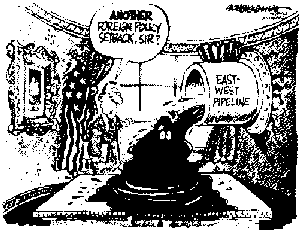 Reagan was seen as a poison container into which we dumped our emotions. |
120
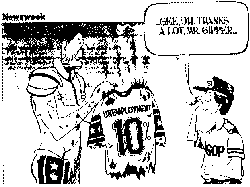 We put so much poison into Reagan that we imagined he smelled bad. |
refugees into our country because Europe was full of "fifth columnists and saboteurs which were undiluted poison that must not be allowed to spread in the New World."(19) So, too, the economic expansion just before Vietnam produced a "Pollution Alert" scare at the end of 1963, when the head of the U.S. Public Health Service imagined that "pollution was growing considerably from the threat of epidemic disease being imported into the U.S. from abroad."(20) The renewed vitality of the American economy at the end of 1982 produced The Great Reagan Poison Alert, when for six months the media was dominated by fears of disease and poisons of all sorts, real and imaginery, usually connected with fantasies of punishment for sexuality. |
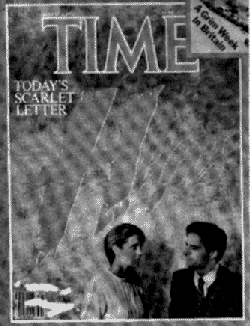 Herpes was seen as our punishment for sex. |
The opening gun of the Poison Alert was a sensationalized Time cover story on the herpes virus, featuring a blood-red "Herpes" on the cover and containing the most horrifying stories that could be found on the "incurable" effects of herpes, concluding that "perhaps not so unhappily, it may be a prime mover to bring to a close an era of mindless promiscuity."(21) For the next two months, the entire press and TV corps seemed to have become addicted to herpes scare stories, usually ending in a tone of "it serves us right" for having too much sexual freedom. "Will Herpes Bring Back Morality To America?" asked a Reader's Digest cover.(22) "Is Disease Shaping a New Sexual Ethic?" asked Mother Jones. (23) America was portrayed as hopelessly lustful, and herpes was thought to be the modern plague sent by God to punish us for our sexual excesses. No |
| FEARS OF IMPOTENCE | 121 |
mention was made of the fact that herpes had been around since Roman times, or that the current version had been widespread for several years without attracting media attention, or that new antiviral medications promised control of the disease. As our economy revived-and as we reduced our sacrificial offerings (the unemployed) which had drained us of our sins so far-we needed a place to put our fantasies that dangerous poisons were building up inside us, and herpes provided a perfect container for these fantasies.
The same explanation holds for the spate of articles that fall claiming that America was militarily weaker than the Soviet Union. The connection between fears of bodily disease and fears of American weakness and communist strength have been common knowledge ever since Col. Jack D. Ripper launched the holocaust in the movie Dr. Strangelove because "the commies were poisoning our precious bodily fluids." Col. Ripper discovered the communist poisoning plot which had so weakened America "during the act of physical love." When Reagan gave address after address to the American people armed with charts which were distorted to show that Russia had more and bigger missiles than we did he was voicing the same paranoid fears of impotence as Col. Ripper's.
Most Americans agreed with Reagan's claims that our national phallus had been shrinking lately, despite all evidence to the contrary. During Reagan's "collapse" phase, we were seized by a hysterical epidemic similar to the one Asians call "koro," where the men in large areas of the country suddenly believe that their penises are shrinking and come running into hospitals holding on to their penises with a string, lest they disappear into their abdomens.(25) Like Col. Ripper, and like Frosch's paranoid patient, we felt we were being weakened by something, and felt that this something (really our own sexuality, our own desires for pleasure, our own revived hopefulness) was becoming more and more poisonous to us each day.
| The way large groups usually objectify these vague poisoning fears is to delegate to individuals the task of acting out what is feared, so it can be seen to exist "out there" in what can be called reality," rather than remain on-ly inside. During Carter's "collapse" phase, we delegated Rev. Jim Jones to act out our poisoning fantasies for us in Jonestown.(26) Four years later, in September of 1982, during Reagan's "collapse" phase, |  Jonestown acted out our poison fantasies during the Carter "collapse" phase. |
122
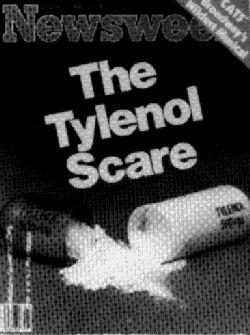 Poison Tylenol capsules set off The Great Reagan Poison Alert. |
several local poisoning incidents began breaking out
in the Middle West - the largest being a milk poisoning
scheme in Cedar Rapids, Iowa(27) - but these were not
reported nationally because no one died from them. On
September 30th, one finally succeeded, in Chicago,
killing seven people with poison which was put into
Tylenol capsules. The Great Reagan Poison Alert was on in
earnest. Each element of the Tylenol poisonings could be traced to earlier elements in our national group-fantasy. The poison used was cyanide, the same as had been used in poisoning the purple Koolade drink in Jonestown. |
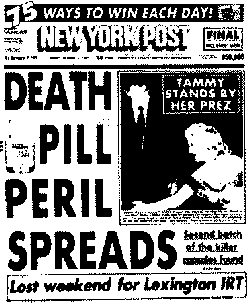 The "Death Pill" was often shown next to Reagan's picture. |
The Tylenol bottle was the same as the popular
"Reaganol" bottles sold in stores across the
country containing jellybeans marked "Temporary
relief from inflationary anxiety . . . package not
child-resistant." Even the jellybeans might have
been linked in the poisoner 5 mind to the story in Time
citing Reagan as saying, as he swallowed a purple
jellybean, "they tell me the purple ones are
poison."(28) In any case, the press underlined the link between Reagan and the Tylenol poisoning wherever it could. The press vividly depicted a "Tylenol Scare in the White House" as "grim-faced secret service agents fanned out through the White House removing bottles of Extra-Strength Tylenol soon after seven people died" and by running headlines on the "Death Pill Peril" next to Reagan's picture.(30) When the main suspect for the Tylenol poisonings, James Lewis, later |
REAGAN'S AMERICA
|
On to
|
To report errors in this electronic
transcription please contact:
[email protected]